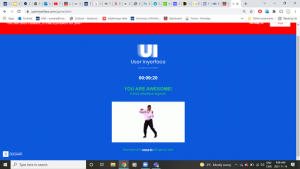Prior to this task, when I would reflect on my own attention, I realized that my ability to maintain my attention is far weaker now than it used to be. Growing up, I would watch a television show or movie and that would be the only thing I was doing. Now, I often find myself divvying up my attention between two or even three screens as I attempt to multitask. If there is a lull in the action of whatever I am watching, I find myself reaching for my phone to scroll social media or play a game. While this would have been nice for me in the days of commercials, now I stream 100 % of my film content so the advertising that used to break up my shows is no longer there. Instead, I experience the advertising at the beginning of videos, on my social media accounts, or sometimes embedded within the show or movie itself as product placement. Ultimately, what I find most interesting is that I perceive my attention skills to have declined.
Having grown up with the rapid developments in technology and digital media, I can still remember a time before I had internet, before I had high-speed internet, and before mobile phones were ubiquitous. I think this gives me (and my generation) as fairly unique perspective in truly having experienced a vast range in the fight for our attention. As a result in the evolution of technology and digital media, I have also noticed my patience to have declined. While I used to wait for my dial-up internet to slowly connect and then slowly load whatever I was trying to access, now I feel frustrated when anything takes longer than a second to load.
While playing this game I noticed instances of my attention and patience struggling with various elements of the site. I found myself quite annoyed by the various pop-ups that recurred frequently throughout. Normally, if a site was this obtrusive, I would have closed it quite rapidly. This is where subtlety would be important for a site. When advertising is subtle it is not perceived to be annoying, thus it is likely more successful as users are not going to abandon the site completely. I also grew quite irritated by the slow scrolling of the window for accepting the terms and conditions. Interestingly, this feature was probably the most in my favor as it theoretically would have forced me to read the text I was accepting. Contrary to other sites where users can easily click accept without even looking at the terms and conditions or can simply scroll to the end quite quickly, this game forced us to scroll very slowly. However, instead of taking the time to read the words, I simply scrolled with one hand while I looked at my phone with my other hand. This would be an easy place for developers to be deceptive and hide important information or as Brignull (2011) wrote, “bury facts within paragraphs of text, so some users will proceed without fully understanding the transaction.”
The site was also adept at influencing me to click on elements I did not necessarily want or need to click on. It did this especially through the use of colour (a large green button, and a bright red banner at the top of the screen) which pulled my attention and influenced me to automatically click on those elements that were emphasized. The colour was more powerful in my quick decision making than the written words.
Ultimately, what I have learnt through this experience and through the resources of this module is that the people behind the websites and advertising have immense power. In their TED Talks, Harris (2017) and Tufekci (2017) both seemed to emphasize that this power could be used for good or for bad. Where it seems to be being used now in more negative ways, they pushed the idea what would happen if we applied these algorithms and powerful advertising strategies towards making our world a better place. This brings me to education; with technology and advertising occupying so much of our brains and the brains of our students, how much room is left for learning? How can we leverage the power and influence identified by Harris (2017) and Tufekci (2017) to encourage learning for our students? These are questions that we need to be thinking about as we struggle to compete for our students’ attention.

References
Brignull, H. (2011). Dark Patterns: Deception vs. Honesty in UI Design. Interaction Design, Usability, 338. Retrieved from https://alistapart.com/article/dark-patterns-deception-vs-honesty-in-ui-design/
Harris, T. (2017, July 28). How a handful of tech companies control billions of minds every day[Video]. Youtube. https://www.youtube.com/watch?v=C74amJRp730&ab_channel=TED
Tufekci, Z. (2017, November 17). We’re building a dystopia just to make people click on ads [Video]. Youtube. https://www.youtube.com/watch?v=iFTWM7HV2UI&ab_channel=TED
I have such admiration for everyone who successfully completed this task. I attempted it but gave up in a rage after about 10 minutes 🙂